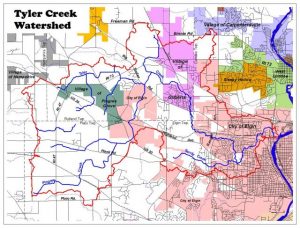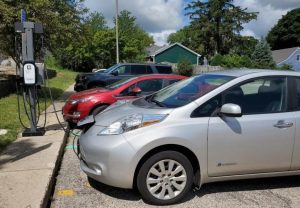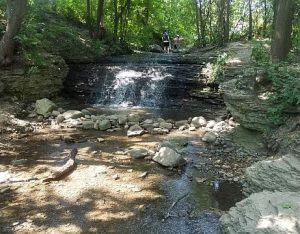There is no ignoring that the recent election demonstrated that we are the (not so) United States of America. We are deeply divided, but on really just a few issues. Can we come together for a unified approach toward these common issues? Well the Fox River has a few lessons for us.
It’s a Watershed Approach
 A watershed is the entire land area that drains to a common place. Whether a creek’s water source is precipitation from above or underground water emerging as a spring or traveling laterally through the soil, it all becomes a creek.
A watershed is the entire land area that drains to a common place. Whether a creek’s water source is precipitation from above or underground water emerging as a spring or traveling laterally through the soil, it all becomes a creek.
Take Tyler Creek as an example. Its watershed is under the jurisdiction of four villages, with their own rules and varied land uses. Tyler Creek accepts its contributions whether they are clean water from above or below, soil from erosion, nutrient runoff, treated sewage, road salt or litter. Tyler Creek continues on its path downhill while providing habitat, aesthetic beauty and some ecosystem services like accepting storm water runoff.
A New Community
As Tyler Creek’s water flows down to the Fox River it is joined with the waters of the Boone, Silver, Flint, and Jelke Creek sub-watersheds (just to name a few). Points of origin are unimportant and there is no arguing about who brought what to the Fox River. The waters of the creeks have joined forces with the river and all have the same objectives and responsibilities. Faced with more challenges, the waters meet with unity and continue their work.
We All Live Downstream 
As American society, can we recognize our differences and unify in our common quest; the pursuit of happiness? Of course we can! In the time before the 1960’s, we violated our waterways with the understanding that they were disposal systems. Then the concept of “we all live downstream” meandered in.
If Burlington, Wisconsin is a good neighbor, then Algonquin, Illinois benefits. And this continues with all the towns downstream to the Illinois River, the Mississippi River and finally to the Gulf of Mexico.
Legislative Unity
It took federal legislation to turn the corner. The Clean Water Act (1972) came with rules that benefit all towns along the river equally. It also came with financial support to implement the measures necessary to achieve its goals, like supporting upgrades to wastewater treatment facilities.
Today, we still have not reached the 1984 goal of all waters of the U.S. being “fishable, swimmable, and drinkable,”. But we are enjoying a MUCH healthier environment nationwide. This demonstrates that if we have the will, we can achieve common goals.
The Right to a Healthy Environment
The Environmental Protection Agency (EPA) sets standards for a wide range of quality-of-life issues, such as water, air, hazardous material handling and energy, thereby benefiting everyone. It operates on the assumption that environmental quality is related to protecting and ensuring American rights and health. The Illinois Constitution dictates that all residents, “have a right to a healthy environment.”
Can we unify in our identification of what is collectively in our best interest and then agree upon the best path to get there? At least we can agree on some strategy, because politics is a science that requires data and compromise.
The Will of the People

The auto emission and fuel efficiency standards set by the EPA in the 80’s was strongly opposed by the auto manufacturing and fossil fuel industries. They claimed it was not technologically possible to achieve them and it would drive them into bankruptcy. Now, along with some new companies, most of the major car manufacturers are developing electric vehicles.
In the 80’s we realized that there was an expanding hole in the upper atmosphere ozone layer. A global initiative, led by countries and private chemical companies, identified problematic chemicals and developed alternatives, resulting in a marked improvement of the ozone layer.
We are in a global war with the climate with record fires, life-threatening tropical storms and serious agricultural impacts on the horizon. Can we come together to meet this challenge? The current pandemic is also waging war on our society. Can we come together to meet that challenge? History has shown that we can if we have a unified will.
Go with the Flow
 Much of a river’s energy is a matter of physics. Finding the path of least resistance is the river’s initial strategy. But when enough kinetic energy (current) meets an obstacle erosion occurs and a new path is created. Can we as individuals, and with whatever factions we identify, come together like a river? Can we see a common goal and together chart a path to get there?
Much of a river’s energy is a matter of physics. Finding the path of least resistance is the river’s initial strategy. But when enough kinetic energy (current) meets an obstacle erosion occurs and a new path is created. Can we as individuals, and with whatever factions we identify, come together like a river? Can we see a common goal and together chart a path to get there?
For a drop of water in Tyler Creek, the creek is its entire community, but its destiny is to become part of the Fox River, Illinois River, Mississippi River and Atlantic Ocean community. Do our activities in the Tyler Creek Watershed impact life in the Atlantic Ocean? In the natural world, all things are connected and in the social world it is the same. Let us realize our differences and find our commonality to address humanity’s current challenges. Together, we are also flowing.




